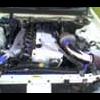Flat Spot
Announcements
-
Similar Content
-
Latest Posts
-
And the full R32 GTR wiring diagrams are also freely available. Hmm.... there's supposed to be an auto replace that would have linked the thread. Here it is, manually
-
Ahh...should have been clearer ~ there's 2 ... SMJ = super multi junction (connector)... ...this is connector 6 & 25 in above image -- body harness to engine loom (6) & body harness to main loom (25) Headlights go to front via connector 6 ; fuel gauge goes to tank sender via connector 25 ...like I say this is R33 diagrams, but at a pinch R34 won't be too far different. *IF* the two ground faults are related, this can be the only place where both wires converge (as one runs to the back, the other to the front)... ....thing is, you probably need to establish if the faults are related (unless you examine that area and find obvious chaffing on the looms there to body ground)....*IF* the fuel gauge is still broken (full needle deflection), I'd be headed for the boot, remove fuel sender wire, key on and measure the voltage there ~ it should be roughly 10volts. If that's ok, check sender to ground resistance...if this is a dead short to ground (and there's fuel in it), then sender has failed or something funky has happened to wiring in the tank. edit: ahh...rereading the thread, this is R32....above fuel sender test still valid tho'
-
By drifter17a · Posted
I just changed the timing belt on my RB25DET NEO and wanted to get some opinions. I’ve been super cautious, did a lot of research, and took my time. I’ve driven the car, and it runs fine. After warming it up, I revved it to 8000 RPM a few times—no issues, everything held up. After the drive, I heard a noise that I think is either the clutch or possibly a tight accessory belt. It’s not constant, just comes and goes. I took the timing cover off to double-check everything: Belt is on properly, Tensioner is tight, Did the 90-degree twist test—belt isn’t too tight or too loose. What still worries me is that I noticed the belt seems to sit a little toward the front edge of the gears, especially on the idler pulley. It even looks like it’s slightly coming off the edge there. Is that normal? My old belt (5 years old, ~3,000 miles) also showed a bit of wear on that same edge, so maybe it’s just how it sits? I’m probably overthinking this, but since it’s my first time doing this on a NEO and the engine is forged, I really don’t want to mess anything up. Also, I’m thinking of swapping to a clear front timing cover with the glass window. Would you recommend NITO or HPI? HPI looks reputable and their covers have 2.5mm thickness, but not sure if there’s a real difference between the two. Any advice or reassurance would be much appreciated! -
40 grit sounds about right, to start. You make some decent cuts/damage in the coating with that, then rapdily scale up to maybe 80 and 120 for the bulk of the actual removal, then fine it off to 180 or 240 perhaps. No need to go any finer than that, and maybe no need to go even as fine as that. Wrap it on a big block and have at it. At least on the hub face.
-



Recommended Posts
Create an account or sign in to comment
You need to be a member in order to leave a comment
Create an account
Sign up for a new account in our community. It's easy!
Register a new accountSign in
Already have an account? Sign in here.
Sign In Now